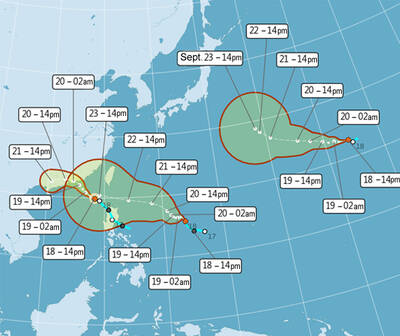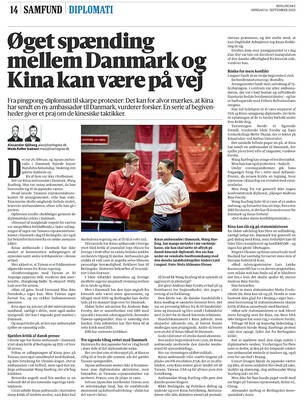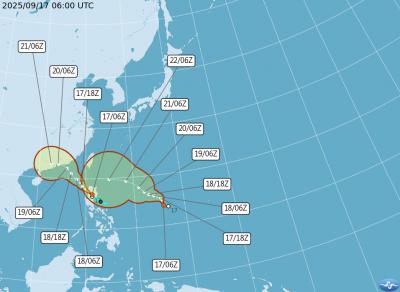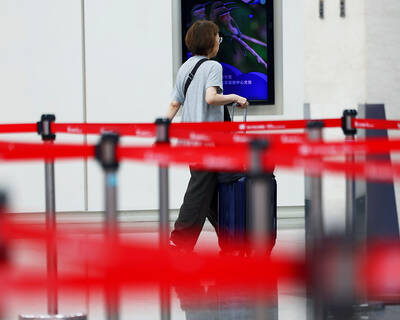The Taitung County Government is studying the feasibility of relocating the ashes of 26 people who died 67 years ago while searching for a US military plane that crashed into a mountain in eastern Taiwan, an official said yesterday.
The victims were among nearly 100 people mobilized to assist Japanese policemen searching for the plane on Sancha Mountain (三叉山) near Guanshan Township (關山), Taitung County, in September 1945, said Feng Wen-ming, a county official in charge of Aboriginal affairs.
At the time, World War II had just come to an end and Japanese colonial authorities had not yet completed a transition of power.
The US plane was carrying 26 US soldiers who had just been released from a POW camp in the Philippines when it hit Sancha Mountain. During post-crash relief operations, rescuers were hit by three typhoons that pounded Taiwan simultaneously with strong winds, torrential rains and hail. Twenty-six of them died as a result.
“It marked the highest death rate for rescue personnel in Taiwan’s disaster relief history,” Guanshan Township chief Huang Jui-hua (黃瑞華) said. “The rescuers were all heroes who sacrificed their lives on an official mission. The incident, however, has hardly been mentioned in recent decades.”
Ten years ago, the Guanshan Township office commissioned Shih Tien-fu (施添福), a research fellow at Academia Sinica, to study the Sancha incident.
According to the study, all 26 of the Americans aboard the plane were killed. Because most of the recovered remains were body parts, US authorities called for the men to be buried on the mountain. Because of the demanding mountain terrain in which the crash occurred, Japanese police authorities also ordered the burial of the cremated remains of the 26 rescuers at the same location near Jiaming Lake.
Before the burial, Japanese police had the right hand of each dead rescuer cut off. The palms were cremated at the scene and the ashes were handed over to the victims’ families.
However, in recent years, the families of the dead rescuers have filed petitions with the Taitung County Government asking that the complete remains of their -ancestors be returned to be reburied in their hometowns. The families said that they have always had a hard time climbing through the mountains to visit their ancestors’ makeshift tombs. Late last year, the county government asked a group of junior high and elementary school teachers to inspect the rescuers’ graves.
Su Chi-sheng, an elementary-school teacher who was part of the group, was quoted by the Chinese-language United Daily News as saying that the remains of the rescuers were sloppily buried and covered with scattered piles of stones.
About 20 years ago, Su said, some family members erected a marble slab engraved with the inscription “brought together by fate” to serve as a gravestone, but time has taken a toll on the marker.
“Windswept and battered by rain, the gravestone has become worn and the paint used to form the letters has chipped off,” Su said.
Over the past decade, many mountain climbers have passed by the rescuers’ graves, but few of them realized that the remains of the rescuers were buried beneath the stones.
“To my knowledge, they tend to see the graves as random piles of stones,” Su said.
Feng said the county government would seek financial support from the central government to relocate the Sancha rescuers’ graves, but only after it conducts further tests to determine whether the four urns seen by the group of teachers beneath the stack of stones truly contain the ashes of the Sancha rescuers.
“If they indeed contain the ashes of the Sancha rescuers, the county government will consider building a shrine to host the urns and erecting a memorial plaque in their honor,” Feng said.

PEAK MONTHS: Data showed that on average 25 to 27 typhoons formed in the Pacific and South China seas annually, with about four forming per month in July and October One of three tropical depressions in the Pacific strengthened into a typhoon yesterday afternoon, while two others are expected to become typhoons by today, Central Weather Administration (CWA) forecaster Lee Ming-hsiang (李名翔) said yesterday. The outer circulation of Tropical Depression No. 20, now Typhoon Mitag, has brought light rain to Hualien, Taitung and areas in the south, Lee said, adding that as of 2pm yesterday, Mitag was moving west-northwest at 16kph, but is not expected to directly affect Taiwan. It was possible that Tropical Depression No. 21 would become a typhoon as soon as last night, he said. It was moving in a

A Taiwanese academic yesterday said that Chinese Ambassador to Denmark Wang Xuefeng (王雪峰) disrespected Denmark and Japan when he earlier this year allegedly asked Japan’s embassy to make Taiwan’s representatives leave an event in Copenhagen. The Danish-language Berlingske on Sunday reported the incident in an article with the headline “The emperor’s birthday ended in drama in Copenhagen: More conflict may be on the way between Denmark and China.” It said that on Feb. 26, the Japanese embassy in Denmark held an event for Japanese Emperor Naruhito’s birthday, with about 200 guests in attendance, including representatives from Taiwan. After addressing the Japanese hosts, Wang

One of two tropical depressions that formed offshore this morning could turn into a moderate typhoon by the weekend, the Central Weather Administration (CWA) said today. Tropical Depression No. 21 formed at 8am about 1,850km off the southeast coast, CWA forecaster Lee Meng-hsuan (李孟軒) said. It is expected to move in a northwesterly direction as it continues building momentum, possibly intensifying into Typhoon Mitag this weekend, she added. The radius of the storm is expected to reach almost 200km, she said. It is expected to approach southeast of Taiwan on Monday and pass through the Bashi Channel between Tuesday and Wednesday,

About nine Taiwanese are “disappeared,” detained, or otherwise deprived of freedom of movement in China each month, the Mainland Affairs Council (MAC) said yesterday. Between Jan. 1 last year and Aug. 31 this year, 188 Taiwanese travelers went missing, were detained and interrogated, or had their personal freedom restricted, with some questioned in airports or hotel lobbies, the council said. In a statement ahead of the Mid-Autumn Festival, the council urged people visiting China for any reason to be highly vigilant and aware of the risks. Of the reported cases, 50 people were “disappeared” after entering China, 19 were detained and 119 had